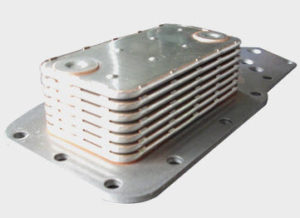Reasons for Excessive Oil Consumption in Diesel Engines
Oil Leakage On Outside of Engine
The most common place for the diesel engine builder to look for leaks, on the outside of the engine, is crankshaft. If nothing is found you can then then work your way up the engine. First, look for any oil leakage at the seals at the end of the crankshaft. If everything looks fine the next logical place to look for leakage at the oil pan gasket and all lubrication connections. If there are still no leaks you should inspect the crankcase breather. This is a very common spot for oil leaks which are caused by a combustion of gas around the pistons. If the crankcase breather is clogged with debris this will cause high oil pressurein the crankcase. The dirty crankcase breather will cause gaskets and seals to crack and leak.
Oil Consumption Into Combustion Area
If you see blue smoke it is usually a telltale sign of burning oil somewhere in the combustion chamber. If oil leaks into the combustion chamber of the diesel engine it is usually a sign of wear and tear somewhere in the engine. There are four common ways for oil to leak into the combustion area of the pistons:
• The most frequent place to check for an oil leakage is between worn valve guides and valve stems. • Check for old and worn components such as pistons, piston rings and liners.
• Check for old and worn components such as pistons, piston rings and liners.
• It is also imperative to check for clogged oil return galleries in the bearings. Clogged bearings will build up oil pressure and cause a leak somewhere else.
• If the compression and intermediate rings are installed incorrectly it can cause oil leaks.
• It is also common to see oil leakage issues past the seal rings in the impeller end of the turbo shaft.
Increased oil consumption can also be the results of using the wrong viscosity of oilfor a particular engine. A brand new engine should not use synthetic oils as they are too thin. The thin oil doesn’t give enough time for the gaskets, liners, rings and bearings to seat properly in a new engine. Standard oil should be used for the first 5,000 miles then a synthetic oil is fine to use. Additionally, a standard oil that is measured with an abnormal viscosity can be caused by fuel leakage into the crankcase or by increased engine oil temperature.
Increased Oil Temperature Reasons
 It is always best to follow the manufacturer guidelines for the type of oil used in a diesel engine. Most large heavy duty diesel engines use SAE 10W30 oil. The maximum allowed oil temperature for SAE 10W30 is 239 F°. This is the temperature of the oil after directly passing through the oil cooler.
It is always best to follow the manufacturer guidelines for the type of oil used in a diesel engine. Most large heavy duty diesel engines use SAE 10W30 oil. The maximum allowed oil temperature for SAE 10W30 is 239 F°. This is the temperature of the oil after directly passing through the oil cooler.
The most common cause of excessive oil temperature is a blockage in the oil galleries in the oil cooler. If the oil cooler isn’t working properly the oil will not be cooled to normal temperatures. Usually, but not always, a restriction in the oil cooler will not cause low oil pressure in the engine.
In diesel engine oil coolers there is a bypass valve that allows the flow of oil in the event of blockages within the oil cooler galleries. The valve is pressure sensitive; usually 25 psi of pressure or more will open up the valve and allow unfiltered, uncooled oil through the system. If there is a system within the engine that needs excess lubrication than normal demand the bypass valve will open. Increased oil temperatures should not be ignored and addressed immediately.
Overall, excessive oil consumption is not a sign of immediate engine trouble but rather minor issues that should be addressed during regular maintenance. Diesel engine will last a long with with regular oil changes, cleaning and replacing of wore parts. If you do see an oil leak or increased oil temperatures you should immediately shut engine down to prevent further damage and seek a professional mechanic.




